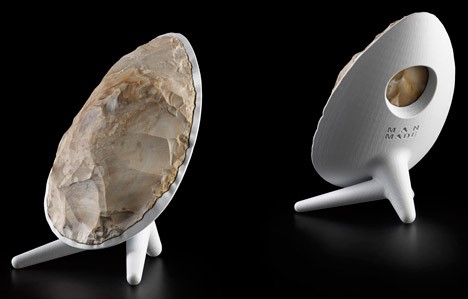Stone-age hand-axes were a functional utility tool as well as prehistoric status symbol, demonstrating primeval man's ability to adapt, innovate and use technology to improve his lifestyle and long-term existence. Among the stone-age community dating back to the Paleolithic Period some 700,000 years ago, hand axes were a sign of success, extraordinary skill and man's ability to provide for his family.
In celebration of this historical milestone, these stone-age tools have received a contemporary 3D printing upgrade. In a collection entitled 'MAN MADE', designers Dov Ganchrow and Ami Drach have recreated a series of nine stone-age tools, in collaboration with leading 3D printer manufacturer, Stratasys.
The MAN MADE series of hand-axes includes flint stones formed using the primeval method of knapping – the art of striking flint with another stone to create a new form. In the stone-age, this production technique was absolutely 'cutting edge,' requiring remarkable expertise and enabling primeval humans to learn life-changing new skills: the ability to cut meat, scrape skins, chop wood, dig holes and self-defense against wild animals. However, some flint hand axes recovered from ancient times were either too large to be handled easily and used practically or had no wear signs from being used. As such, it is thought that primeval men also used larger hand-axes as a symbol of their social standing and virility.
Putting a mirror to the stone-age practice of knapping, Ganchrow and Drach decided to use Stratasys 3D printing to produce contemporary axe handles for the MAN MADE collection. 3D printing is in a way a modern day equivalent of knapping – immensely useful, cutting edge and giving new custom form to suit the need.
In selecting arguably the most progressive 3D printing technology in use today – Stratasys PolyJet technology – Ganchrow and Drach were able to build on the skillfulness of our ancient ancestors, introducing modern day product design and technology to increase the effectiveness and aesthetic beauty of each tool.
'Stone hand-axe' number 8: Custom ergonomic axe handle 3D printed in 16-micron layers using Stratasys PolyJet technology for precision fit. Photo credit: Moti Fishbain
'Stone hand-axe' number 8: Custom ergonomic axe handle 3D printed in 16-micron layers using Stratasys PolyJet technology for precision fit. Photo credit: Moti Fishbain
To achieve this, several flintstones were scanned by Dr. Leore Grosman's digital lab at the Hebrew University of Jerusalem's Institute of Archaeology. Ganchrow and Drach then used industry-leading PolyJet technology, producing a 16-micron layer surface finish to create ergonomic design artifacts on the basis of the scanned stones, enabling each axe handle to custom fit the contours of its flint stone with absolute precision. They also used Stratasys VeroGray 3D printing material, which provided a tactile, flawless surface finish with attributes – not unlike the original stone-age tools.
The MAN MADE series of tools was designed to celebrate man's incredible achievements. By blending technologies from the farthest ends of human existence, Ganchrow and Drach were able to showcase how simple designs powered by clever thinking can translate into beautiful, functional and history changing objects.
MAN MADE has so far featured in two prestigious exhibitions. Any Tokyo, held at the 600-year-old Jojo Ji Temple, Japan, in 2014 was a design event bringing tomorrow's applied design and ideas together under one roof. MAN MADE was shown in conjunction with Ganchrow and Drach's earlier "BC-AD" collection to speculate on man's first and longest-lived tools, reflecting on issues such as branding, agronomics, courtship, manufacture and consumerism, as well as survivalism.
MAN MADE next appeared at BOZAR, The Centre for Fine Arts, in Brussels throughout June 2015. The exhibit's next stop is the Geological Museum in Ramat Hasharon, Israel, in September 2015 -- an intimate solo exhibit showing Ganchrow and Drach's greater scope of works dealing with contemporary prehistoric stone tools. The MAN MADE collection will then move on to the MUDEC Museum in Milan in October 2015.
www.stratasys.com
